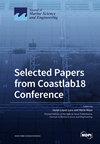基于地理信息系统的海上风电场优化选址,支持零排放轮渡航线
IF 2.8
3区 地球科学
Q1 ENGINEERING, MARINE
引用次数: 0
摘要
为了在 2050 年前实现船舶净零排放,并与国际海事组织 2023 年温室气体战略保持一致,海运业必须在 2030 年前大幅增加零排放船舶。向全电动渡轮过渡需要通过可再生能源(RES)加强能源供应,以实现完全的温室气体减排和净零排放。本研究提出了一个基于 GIS 的框架,用于优化选择海上风电场位置,以满足沿海航线电动轮渡运营的能源需求。该框架包括两个阶段:设计岛屿之间或通往大陆的可行零排放轮渡路线;根据国家立法和学术文献,通过评估技术、空间、经济、社会和环境标准,确定最佳海上风电场地点。其目的是创建一个灵活的框架,为在区域层面建立可持续电动轮渡运营提供决策支持,并以战略性定位的海上风电场为后盾。该研究将这一框架应用于希腊沿海航运网络,重点关注未来具有电气化潜力的地区。研究结果可帮助决策者利用空间决策支持系统 (SDSS) 提高运输效率,发展可持续的岛屿社区。本文章由计算机程序翻译,如有差异,请以英文原文为准。
GIS-Based Optimal Siting of Offshore Wind Farms to Support Zero-Emission Ferry Routes
To achieve net zero emissions from ships by 2050 and align with the IMO 2023 GHG strategy, the maritime industry must significantly increase zero-emission vessels by 2030. Transitioning to fully electric ferry lines requires enhanced energy supply through renewable energy sources (RES) for complete GHG mitigation and net-zero emissions. This study presents a GIS-based framework for optimally selecting offshore wind farm locations to meet the energy demands of electric ferry operations along coastal routes. The framework involves two stages: designing feasible zero-emission ferry routes between islands or to the mainland and identifying optimal offshore wind farm sites by evaluating technical, spatial, economic, social, and environmental criteria based on national legislation and the academic literature. The aim is to create a flexible framework to support decision making for establishing sustainable electric ferry operations at a regional level, backed by strategically located offshore wind farms. The study applies this framework to the Greek Coastal Shipping Network, focusing on areas with potential for future electrification. The findings can aid policymakers in utilizing spatial decision support systems (SDSS) to enhance efficient transportation and develop sustainable island communities.
求助全文
通过发布文献求助,成功后即可免费获取论文全文。
去求助
来源期刊

Journal of Marine Science and Engineering
Engineering-Ocean Engineering
CiteScore
4.40
自引率
20.70%
发文量
1640
审稿时长
18.09 days
期刊介绍:
Journal of Marine Science and Engineering (JMSE; ISSN 2077-1312) is an international, peer-reviewed open access journal which provides an advanced forum for studies related to marine science and engineering. It publishes reviews, research papers and communications. Our aim is to encourage scientists to publish their experimental and theoretical results in as much detail as possible. There is no restriction on the length of the papers. The full experimental details must be provided so that the results can be reproduced. Electronic files and software regarding the full details of the calculation or experimental procedure, if unable to be published in a normal way, can be deposited as supplementary electronic material.
 求助内容:
求助内容: 应助结果提醒方式:
应助结果提醒方式:


